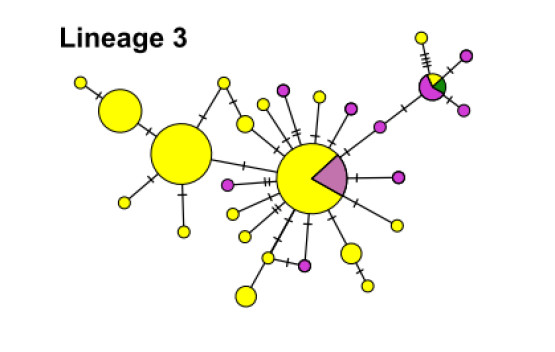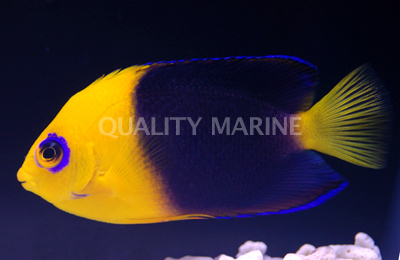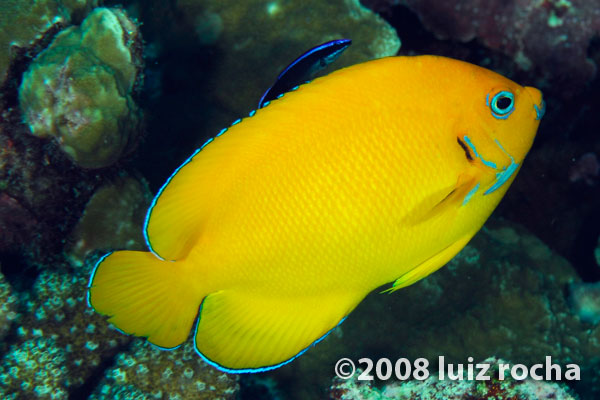A new study is calling into question whether the recently described Cocopeel Angelfish (Centropyge cocosensis) is truly a distinct species or just a yellow imposter. While aquarists have long appreciated the unique qualities of this fish—most notably, its blue iris—it was only in June of this year that it was scientifically described as separate from the true Lemonpeel Angelfish (C. flavissimus), a species found far to the east in the Central Pacific Ocean. The vast geographic distance that separates these two yellow dwarf angelfishes, as well as their consistent phenotypic differences, made for a strong argument that these were not truly the same fish. However, the genetic data presented in the description (Shen et al 2016) provided fairly weak support for this conclusion. Though there was a minor difference noted for C. cocosensis in one of the three genes examined, this species tended to show a very close relationship with another fish from the Eastern Pacific Ocean, C. eibli. This raises a very obvious question—is the Cocopeel Angelfish just a xanthic variation of C. eibli?
To answer that question, a recently published study (DiBattista et al 2016) sampled a large number of specimens from across the Indo-Pacific, giving these researchers an unprecedented look into the finer evolutionary details of these confounding fishes. An impressive 88 specimens of C. cocosensis were genetically sequenced (versus just 6 in the description of Shen et al), and the results showed that these grouped strongly with C. eibli, lending support to the notion that this yellow fish is perhaps just an unusual regional variant.

This graph illustrates the close relationship of C. eibli (purple) and C. cocosensis (yellow), showing how the two share identical sequences in the Cytochrome B gene analyzed. Central Pacific C. flavissima belong to a distinct lineage and are thus not included in this graph. The circles signify a unique genetic sequence (larger circles signify an abundance of a particular “haplotype”), while the lines connecting them numerically represent mutations. Modified from DiBattista et al 2016
This makes sense when we look at the biogeography of this species complex, as the only place we find the cocosensis phenotype is in the area of overlap where the Indian and Pacific Oceans meet. Many other reef fishes are known to produce hybrids in this small corner of the ocean, and perhaps the most plausible explanation for this yellow angelfish is that it’s the anomalous offspring caused by interbreeding of the West Pacific C. vrolikii and the Indian Ocean C. eibli. These two are known to produce another distinctive cross, the so-called Black Tiger Angelfish, which is documented from the oceanic reefs off Northwestern Australia (another region of biogeographic overlap).

Black Tiger Angelfish (C. eibli X C. vrolikii), from Rowley Shoals. Credit: Rudie Kuiter / DiBattista et al 2016
But there are still many questions that have yet to be resolved. For example, if C. cocosensis really is just another hybrid, why does it look so little like it’s presumed parent species, C. eibli and C. vroliki? And why are there no Cocopeel or Tigerpyge phenotypes documented from Northwestern Australia, as both parent species occur here as well. This could certainly be seen as evidence that C. cocosensis is (or was) a true species at one point, but perhaps now it has so greatly interbred with C. eibli that it is no longer genetically distinct in a meaningful way.

Tigerpyge Angelfish, note the similarly blue iris compared to “C. cocosensis” Credit: Quality Marine
Also germane to this discussion is the distantly related C. joculator, the only other endemic angelfish in this region. Among reef fishes, there are actually very few species that are truly restricted to this unusual biogeographic range in the Eastern Indian Ocean, even among groups noted for high levels of regional diversification. This raises the obvious question of why there should be two unique dwarf angelfishes here, especially since both of these groups contain relatively widespread species elsewhere. To understand one, we likely need to better understand the other, and, at the moment, we know little about the evolutionary origins of the Joculator Angelfish, other than that it’s closest relative is a widespread species in the Central Pacific Ocean, Centropyge multicolor.

Centropyge joculator, the only other angelfish known only from Cocos-Keeling and Christmas Islands. Credit: Quality Marine
The biggest limitation right now for understanding this group’s confusing evolutionary history is that we have useful data from just a tiny portion of their genomes. Only three mitochondrial genes—16S, CO1, cytB—have been looked at in detail, and these support a scenario of biogeographic speciation, with separate lineages in the Eastern Indian and Pacific Oceans that don’t correspond to the phenotypic difference seen in the Cocopeel Angelfish. But it is still possible that nuclear data will paint a different picture, even though, to date, studies have found little resolution in the nuclear genes that have been sequenced thus far. So, to wrap this all up, is C. cocosensis a species? The answer is that we don’t really know at the moment.
- DiBattista, J. D., Gaither, M. R., Hobbs, J. P. A., Rocha, L. A., & Bowen, B. W. (2016). Angelfishes, paper tigers and the devilish taxonomy of the Centropyge flavissima complex. Journal of Heredity. 107 (7): 647-653. doi: 10.1093/jhered/esw062












0 Comments